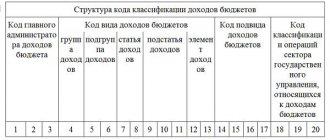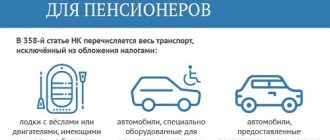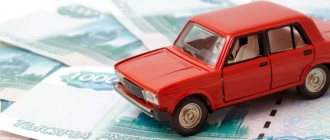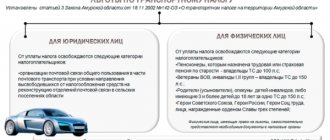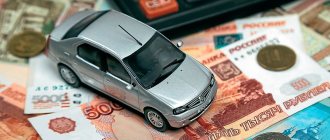With the increase in the number of cars in the Russian Federation, the transport tax covers an increasing number of payers who are interested in the algorithm for its calculation and payment rules. One of the nuances of this tax is the existence of an increasing coefficient for expensive cars. What is the increasing coefficient for transport tax? How does it apply to individuals and legal entities? Who installs it? When is an increasing coefficient applied and when is a decreasing coefficient applied? We will answer these and other questions in this article.
How does it affect transport tax?
All owners of cars (except for preferential categories and certain cases) and other vehicles annually pay transport tax, calculated as follows:
Transport tax = Tax base (engine power in hp) * Tax rate * Increasing factor * Number of months of use / 12
For each car, the tax value is calculated individually. The tax base is calculated based on engine power, but the tax rate can vary from region to region (federal values can be increased up to 10, and sometimes more times).
One of the important factors determining the amount of transport tax is the increasing coefficient. It was introduced not so long ago - in 2014. The final amount of tax paid due to the increasing coefficient can increase significantly - from 1.1 to 3 times.
For example, if the tax amount for the year was 10,000 rubles, then if the luxury tax is paid, its amount can increase to 11,000 - 30,000 rubles.
Procedure for paying tax by legal entities
Organizations that own cars must calculate the tax amount themselves. They need to make advance tax payments quarterly in the amount of ¼ of the tax amount. At the end of the year, the balance of the tax amount is paid, and a tax return is drawn up, which is submitted to the Federal Tax Service no later than February 1 of the year following the tax period.
Tax and advances are paid at the location of the car within the time limits approved by local legislation. If a multiplying factor is applied to a car, the procedure for transferring tax does not change.
Which cars do you have to pay more for?
The increasing coefficient began to be applied for the first time in 2014 after the corresponding additions were made to Art. 362 of the Tax Code of the Russian Federation (with the entry into force of Federal Law No. 214-FZ of July 23, 2013).
Luxury car tax payers should remember that they do not have to pay it separately. Moreover, it is impossible to calculate it without reference to the transport tax. It will be easier for individuals than for business representatives, because they will not have to calculate the amount of deductions themselves - all information will be indicated in the notification of the need for payment.
However, sometimes people still want to know whether the vehicle tax increase applies to their cars. It is important to understand that it is used exclusively for passenger cars. That is, if a person purchased an expensive truck or bus, then he will not have to pay for the “luxury”.
Any car included in the “luxury” list must simultaneously satisfy a number of the following criteria:
- passenger car;
- price – not less than 3 million rubles;
- The car is on the list of the Ministry of Industry and Trade.
Every year, the Ministry of Industry and Trade publishes a list of luxury cars on its website. So, to calculate the tax in 2021, you need to use the 2021 list, because before December 1 you need to pay the tax for the previous reporting period. The information in the list is divided into several groups depending on cost. When calculating the tax paid in 2021 (for 2021), 909 car models may be subject to the increasing coefficient. If a car is not included in this list, then it will not be classified as luxury, regardless of the cost. In general, the list of the Ministry of Industry and Trade has the following groups of cars:
- Priced from 3 to 5 million rubles. There are 424 of these on the 2021 list. Expensive cars in this class include models from brands such as Audi, BMW, Infiniti, Jaguar, Land Rover and others.
- Priced from 5 to 10 million rubles. There are 320 of them when calculating the tax for 2017. There are cars from Aston Martin, Audi, BMW, Bentley, Lexus, Maserati, etc.
- With a price of 10 to 15 million rubles. There are only 95 such models for 2017. They include brands like Aston Martin, Bentley, Ferrari, Lamborghini, Porsche.
- Priced at more than 15 million rubles. There are 70 of them. There are models from such famous brands as Bugatti, Ferrari, Lamborghini, Rolls-Royce.
The information in the list is presented in tabular form and contains information about the make and model of the car, the type and size of the engine, as well as the period from the date of manufacture during which the luxury tax is paid.
The presence of a car on the list of the Ministry of Industry and Trade does not mean that you will necessarily have to pay tax on it. It is necessary to pay attention to the last column, which indicates the maximum (sometimes minimum) number of years that have passed since the date of issue at which the increasing factor must be used.
Example . Starovoitov purchased a 2012 Rolls-Royce Phantom Coupe from Yusupov in 2021. After the purchase, he became interested in whether he would have to pay luxury tax for the previous period in 2021?
This car model is actually on the 2021 list of the Ministry of Industry and Trade. However, taking into account the date of manufacture (when calculating the increasing coefficient, both the year of manufacture and the year for which the tax is paid are taken into account - when calculating the tax rate, the year of manufacture, on the contrary, is not taken into account), the car is already more than 4 years old. Consequently, Starovoitov will not have to pay luxury tax.
Tax abolition in the future: reality or dreams?
The expectations of those who hoped for the abolition of the transport tax in 2018 will most likely not be met. Such a bill has not even been submitted for consideration. But amendments to the current order are being considered.
However, given the urgent need for adjustments to transport taxation, hope should not be lost. Perhaps in the future they will be justified.
You can find out what alternatives to the transport tax are being considered in the following materials:
- “Will transport tax be replaced by environmental tax?”;
- “Transport tax: changes 2017-2018”;
- “Is transport tax included in the price of gasoline?”
Size of the multiplying factor
In order to correctly calculate the amount of tax (for legal entities) or to check the accuracy of the information in the notification (for individuals), you need to know the size of the increasing coefficient.
For 2021
For 2021, transport tax is paid by individuals and legal entities in 2021. In this case, when calculating, you need to use the old values:
| Price | Number of years since graduation | Applicable coefficient |
| 3 – 5 million rubles | Less than 1 | 1,1 |
| 1 – 2 | 1,3 | |
| 2 – 3 | 1,5 | |
| 5 – 10 million rubles | Up to 5 | 2 |
| 10 – 15 million rubles | To 10 | 3 |
| Over 15 million rubles | Up to 20 | 3 |
Moreover, you additionally need to look at the age requirements in the list of the Ministry of Industry and Trade, since different car models have their own values.
Example . Evgrafov owns a 2021 Audi R8 quattro. For 2021 he will pay transport tax. What magnification factor should he use? This car is included in the list of cars worth from 5 to 10 million rubles. Moreover, the corresponding coefficient is applicable to cars under 3 years old. In this case, you will have to pay luxury tax using coefficient 2.
From 2021
Starting from 2021, the calculation of the increasing coefficient has changed slightly after the entry into force of Federal Law No. 335-FZ of November 27, 2017. From January 1 of this year (according to the new rules, payments for 2021 will be made in 2021), the coefficients for cars with a price of 3 to 5 million rubles have changed. Now the three subgroups are combined into one - up to 3 years. A single coefficient is established for them - 1.1. In general, the table of increasing coefficients looks like this:
| Price | Car age | Coefficient |
| 3 – 5 million rubles | Up to 3 years | 1,1 |
| 5 – 10 million rubles | Up to 5 years | 2 |
| 10 – 15 million rubles | Up to 10 years | 3 |
| From 15 million rubles | Up to 20 years | 3 |
This means that the amount of tax, taking into account the increasing coefficient, for owners of new cars in the price category from 3 to 5 million rubles will decrease.
What is it and what are the purposes of its introduction?
Luxury tax (LRT) is a transport tax for foreign-made cars. Domestic cars do not fall under it. The tax was introduced on January 1, 2014, after changing paragraph 2 of Article 362 of the Tax Code of the Russian Federation, according to which all car owners who are subject to the said legislative act must pay an increased vehicle tax based on a special coefficient.
The objectives of introducing the tax are as follows:
- Import substitution. Only imported cars are subject to the tax.
- Replenishment of the regional budget through payments.
- Changing the priority of purchasing foreign cars to domestic ones.
In addition, the tax takes into account factors such as the cost of the vehicle and engine power.
Reference! In 2021, more than 900 vehicles were included in the luxury tax list. Compared to 2021, this figure is 200 vehicles more.
Is it possible not to pay luxury tax?
The increasing coefficient itself does not provide for any preferential categories. The only thing that can get rid of its use is exemption from transport tax in principle. For example, these categories include the following types of vehicles:
- cars with special devices for transporting disabled people;
- cars with power up to 100 hp. pp., at the disposal of social protection authorities;
- stolen cars;
- cars that are the property of federal government bodies or executive authorities.
If the car is not included in any categories, then you will have to pay transport tax, and if the previously stated conditions are met, an increasing coefficient will be applied to it.
Procedure for paying tax by individuals
For individuals, tax amounts are calculated by specialists from the Federal Tax Service, guided by the data provided to them by organizations registering vehicles. Individual car owners are required to transfer the tax to the budget using a receipt sent by the tax authorities no later than December 1 of the year following the year for which the tax was calculated.
Note! When purchasing an expensive car, you do not need to specifically notify the tax authorities (neither an individual nor a legal entity), but the legal entity will be required to apply an increasing coefficient when independently determining the tax, including for advance amounts.
General calculation procedure
To calculate the tax taking into account the increasing coefficient, the car owner must:
- Make sure that his car is on the list of the Ministry of Industry and Trade and is within the declared age.
- View the power of your engine. It will be the tax base. You need to use values in l. s., not kW. If the power is written in kW, it must first be converted to hp. With.
- Find out the tax rate in your region. They are usually specified in regional legislative acts. Additionally, the power and age of the car may be taken into account.
- Select the appropriate multiplying factor.
- Multiply the resulting values. If the car was purchased during the reporting period, then you will additionally need to multiply the resulting value by the number of months of ownership divided by 12 months.
This will complete the tax calculation. Individuals calculate the value themselves to verify accuracy, since the amount payable is sent to them in the notification.
Prospects for amendments
Many expected drastic amendments in 2021, but they never happened. But the question of what might still happen worries many. And then about the forecasts.
Many say, including in the State Duma, that it would be more expedient to replace the fuel tax with an excise tax, which all motorists already pay when purchasing gasoline. This fee should also be used for the development of highways. And this is quite logical.
Such proposals are justified by the fact that each driver will pay money in proportion to how often the car is driven and the roads are used. But in order for the TN to be abolished, the excise tax must be raised quite substantially, which will greatly increase the cost of fuel.
But for now these are just discussions. Maybe there will be some adjustments already in 2021, we just have to wait.
Similar articles
- The current increasing transport tax coefficient
- Calculation of transport tax 2017
- Transport tax when selling a car
- Calculation of car tax from 2018
- Increasing factor: transport tax


